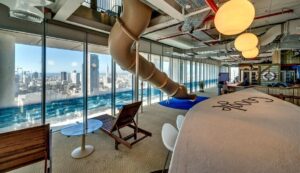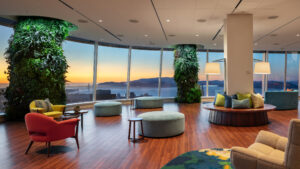As work evolves, it’s crucial to understand the new paradigms shaping our workplaces. Welcome back to our Unworking Weekly mini-series, inspired by new book “Unworking: The Reinvention of the Modern Office” by Philip Ross & Jeremy Myerson.
Over the next twelve weeks, we will explore the themes of each chapter, offering insights into the book’s vision for the future of work and the workplace. For the past century, offices have been integral to society, influencing everything from city architecture to daily routines. However, the pandemic triggered a re-evaluation of the office’s role, promoting a shift away from outdated practices.
Each chapter of Unworking explores the various facets of the evolving workplace landscape. For this week’s blog, we look at Chapter 4: Experience. This chapter examines how the office environment is being transformed to prioritise the experience of the people working in these spaces. By focusing on creating engaging and innovative workplace experiences, this chapter emphasises the importance of enhancing the overall quality of life for employees, which in turn fosters a culture of productivity and well-being.
In recent years, the transformation of office design has become a hot topic of discussion. While much attention has been given to functionality, efficiency, and aesthetics, the true experience of the people working in these spaces often took a back seat. As we continue to evolve, the emphasis on creating a pleasurable, engaging, and even fun office experience is becoming increasingly important. This focus on prioritising the human experience in the workplace represents a major shift in our approach to work environments.
Experience, in the context of work and workplace, involves all the interactions, both physical and emotional, that employees have within their work environment. It includes everything from the design and ergonomics of the office space to the cultural and social aspects of the work community. The goal is to create an environment that not only supports productivity but also enhances well-being, creativity, and engagement.
The Rise in Experience-Based Roles
One of the most significant trends in enhancing workplace experience is the emergence of new job roles dedicated to curating and managing these experiences. Positions like the Chief Experience Officer or ‘vibe manager’ are becoming more common, reflecting the growing importance of this field. These roles focus on creating environments that positively impact employee wellbeing, incorporating elements like yoga, in-person and virtual happy hours, mindfulness, and spaces for relaxation and creativity.
According to a study by Deloitte in their Global Human Capital Trends report published in 2017, 80% of executives rate employee experience as very important or important to their organisation’s success, yet only 22% believe their companies are excellent at building a differentiated employee experience.
An example of this commitment is LinkedIn, where the role of the Experience Design Lead is key in creating an engaging and supportive workplace. This includes everything from designing collaborative spaces to organising wellness programs. These initiatives are crucial as LinkedIn prioritises employee experience, which is recognised as a top trend by 71% of talent professionals according to LinkedIn’s Global Talent Trends Report. LinkedIn consistently ranks highly on the Great Place to Work lists, with 96% of employees testifying it’s a great place to work.
These praises highlight LinkedIn’s commitment to fostering innovation, teamwork, and employee well-being. By investing in these initiatives, LinkedIn not only enhances job satisfaction but also boosts productivity and supports a diverse and inclusive workplace culture, as evidenced by its inclusion on Forbes’ Best Employers for Diversity list.
Designing for Innovation
Innovative office designs are increasingly being implemented to foster creativity and collaboration. These designs often include project rooms, creative labs, and spaces for spontaneous collisions that encourage employees to think differently and collaborate with colleagues from various departments and specialties.
An example of this can be seen at the Google Campus in Tel Aviv, where the physical environment has been thoughtfully designed to encourage creativity and collaboration.
The campus has a variety of spaces tailored to different work styles and needs, from themed meeting rooms that have unique atmospheres beneficial for brainstorming to large open-plan areas that facilitate spontaneous collisions and idea sharing. One of its standout features is a rooftop garden, landscaped to offer a peaceful yet stimulating environment for informal meetings and creative discussions.
This intentional design encourages employees to move beyond traditional office layouts, advocating a dynamic work culture where ideas flow freely, and collaboration increases. These environments not only enhance productivity but also contribute to a sense of community and shared purpose among team members, aligning with modern workplace trends that prioritise both employee well-being and organisational innovation.

Health and Well-Being
Post-pandemic, there has been a heightened focus on health and well-being within the workplace. Companies are incorporating biophilic design elements, daylighting through specialised lighting and larger windows, and spaces for mindfulness and reactional activities like yoga to improve employee physical and mental health, as well as productivity.
Salesforce’s Ohana Floor in San Francisco is designed with employee well-being in mind. It includes meditation rooms, a fitness centre, and plenty of natural light and greenery to create a relaxing and health-promoting environment. The combination of natural elements and green spaces not only enhances the aesthetics of the workplace but also contributes to a healthier and more inspiring atmosphere for employees.

As we look towards the future, the focus on workplace experience is set to become a primary driver of change in work and the workplace. By prioritising new roles dedicated to experience, designing spaces that foster innovation, and emphasising health and well-being, companies can create workplaces that not only support productivity but also enhance the overall quality of life for their employees.
Readers can dive deeper into the exploration of workplace experience and its impact on the future of work in Philip Ross and Jeremy Myerson’s latest book, Unworking: The Reinvention of the Modern Office.
Grab your copy of Unworking from Amazon here.

